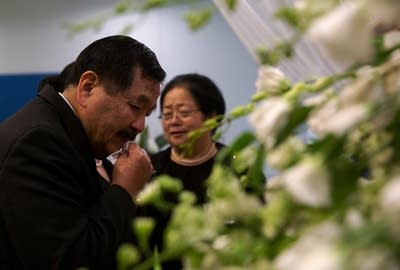The ‘Glass Man’: How a former CIA worker helped bring the Hmong to America
The U.S. government once deemed Hmong refugees unsuitable for American resettlement. Yang See, who had worked for the CIA, made the case they belonged.

Go Deeper.
Create an account or log in to save stories.
Like this?
Thanks for liking this story! We have added it to a list of your favorite stories.
One of the first Hmong refugees to set down roots in the United States was a quiet, humble man. Friends and family say Yang See didn’t always have much to say, but when he spoke, people listened.
Maybe the St. Paul man’s unassuming demeanor is why some are just beginning to realize his enormous legacy: helping persuade the U.S. government to open its doors to an ethnic group once considered unsuitable for resettlement.
Yang See, who died in August at 72, worked as principal assistant to the liaison between the CIA and the Lao Royal Army under the radio code name “Glass Man” at the height of the Secret War in Laos.
As the Vietnam War raged on in the 1960s and mid-1970s, thousands of Hmong soldiers died aiding America’s anti-communist efforts in neighboring Laos. But it was a clandestine CIA operation, and today those former soldiers are not recognized as U.S. veterans.
Turn Up Your Support
MPR News helps you turn down the noise and build shared understanding. Turn up your support for this public resource and keep trusted journalism accessible to all.
In light of this, state Sen. Foung Hawj, DFL-St. Paul, said it’s important for Americans to recognize Yang See’s contributions. His knowledge of several languages, including Hmong, English and Lao, was a key asset to the CIA. And as communists seized power in Laos in 1975, he helped Hmong refugees flee the war and find safe harbor.
“His legacy will not be forgotten,” Hawj said. “Now that we as American elected officials know what he did for this country, we certainly appreciate his sacrifice and valor.”
‘We would have been arrested’
In the eyes of his wife of more than over 40 years, Yang See wasn’t like other Hmong men she had met.
While Pia Lee observed many other Hmong women staying in the house after they married, she said her husband always took her along to social events, where she met dignitaries from around the world.
She also saw her husband, time and time again, give away their money to families in need.
“He gave them food, he gave them money, he gave them the help to get through,” Pia Lee. “I’m very proud of him.”
As the communist group Pathet Lao was on the brink of taking over Laos in 1975, the CIA would only evacuate about 2,500 high-ranking military officers and their families, said Yang Dao, a social sciences scholar and former politician in the Lao government.
Frustrated, Yang See decided to take matters into his own hands and his own wallet. He paid for hundreds of refugees to escape the country, including Yang Dao and his 37 family members, and cross the Mekong River so they could reach the refugee camps in Thailand.
Yang Dao said when he and his relatives reached the river, they quickly climbed into four motorboats paid for by Yang See.
About 15 minutes after they had left shore, Yang Dao saw communist soldiers coming to inspect their cars.
“Without Yang See, we would have been arrested,” said Yang Dao, who lives in the Twin Cities.
Yang See recalled these harrowing rescues in “Sky is Falling: An Oral History of the CIA’s Evacuation of the Hmong from Laos,” published in 1999. He told author Gayle Morrison that he asked the Lao border police for help getting refugees to Thailand. The commander’s price was too high, so Yang See paid for 50 fishing boats instead.
The refugees boarded the boats, with Yang See catching the last one, and sailed across the border.
Once in Thailand, a governor told Yang See there was no space for the Hmong in existing camps. With the help of two Thai contractors, he cleared out a deserted temple and set up the Nong Khai refugee camp.
“That’s history!” Yang See told Morrison.
A convincing case
Even after the Hmong and other highlander refugees from Laos arrived in refugee camps, they were not considered suitable for resettlement by the American government.
The U.S. considered the Hmong to be “illiterate” and “people living in the hills” who would not be able to adjust to modern life in America, said Yang Dao, the former Lao official.
Hoping to persuade the U.S. to open its doors to the refugees languishing in the Thai camps, the two men traveled to Washington, D.C., in November 1975.
“When [Yang See] came here, he spoke English very well. So, he said to the State Department officials, ‘I speak French, I speak Lao, I speak Hmong. If you welcome the Hmong, they would be able to speak English like me,’” Yang Dao recalled.
A month later, Yang See received a call from the Secretary of State’s office telling him the country had begun accepting the refugees from Laos into the resettlement program.
“We’re not only mountain people not knowing anything,” said his wife, Pia Lee. “Our Hmong people [are] very quickly learning, very smart. Only that we don’t have opportunity.”
In early October, on a day when Yang See would have turned 73, a long list of speakers turned out to his funeral in St. Paul to tell the story of how he touched their lives. About 2,000 people paid their respects over the course of the two-day funeral.
“As I know Mr. Yang See from 1956 to the last day of his life in Minnesota,” Yang Dao said. “He is a good man, a man with humility, a man with a good heart to help people because he loved everybody.”
Yang See’s wife, Pia Lee, said she hopes others will hear of his compassion and kindness.
Today, more than 300,000 Hmong Americans call the United States home, and Minnesota has one of the largest Hmong communities in the nation.
“It’s a little late to cheer with him,” she said, “but I think his spirit is going to be around with us.”








